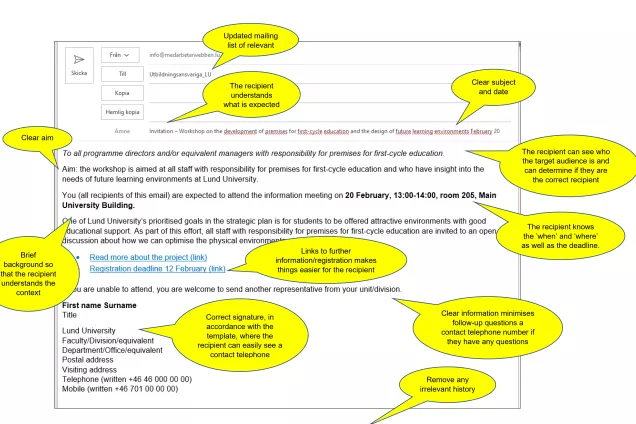Tips and advice on email management
for internal and external emails
Please find below some recommendations on how you can manage emails. The aim is to streamline our communication channels and make things easier for recipients.
General tips
- It is preferable to send one email for each matter rather than several matters in one email.
- Avoid unnecessary emails. Think carefully before using reply all.
- Use an out-of-office reply when you are away from your computer for longer than one business day. Refer to a colleague if possible.
- It is a good idea to reuse standardised responses as templates for recurring emails, see example.
- Provide information on the processing of personal data at Lund University, see example.
Sending emails
Recipient
- Think carefully about WHO is to receive the information.
- Avoid sending emails to recipients who are not directly involved.
- At the top of the email, specify the main addressee/s and who is copied e.g. ‘To all finance officers…’
Contents
- WHAT. Clarify the subject in the subject line; this makes it easy to search.
- WHY. State the purpose of the email in the subject line, e.g. ‘for information’, ‘for sharing’ or ‘for action’, if relevant.
- WHEN. Is there a deadline, point iy out clearly, and point it out in the subject line.
- Write clearly! Avoid using difficult or bureaucratic terms.
- Specify what is expected of the recipient, e.g., ‘Each unit is to respond to…’
- It is a good idea to use bullet points if there are several points to be made.
- When referring to additional information or registrations, always use a clickable link. That way, the recipient does not have to spend time looking it up themselves.
- If you have attached a file, state that in the text.
- Use exclamation marks and capital letters sparingly. Be polite.
- Sign off with a signature according to LU recommendations.
Forwarding of information
- When forwarding: remove any irrelevant information from the email, previous conversations and recipients etc.
- Specify what is relevant to the recipient. Clarify why the recipient is receiving the information.
- If you would like the information to be shared, prepare a final text for dissemination, which is easy to use directly. If possible, provide the text in both Swedish and English.
Personal data in emails (GDPR)
- Do not send personal data, for example, personal identity numbers. Read the University’s information security policy
Private/professional matters
- It is not permitted to receive and send university-related matters from and to a personal email address.
- It is not permitted to automatically forward emails to an external email address.
- Only a limited number of personal emails may be received and sent from the University’s email address.
Public documents and archiving
Remember that emails you send (and receive) may constitute public documents. Which emails are public documents is determined partly by the content and partly by whom the sender or recipient is.
Contact
Anna Mansfeld
Communications officer
Anna [dot] Mansfeld [at] kommunikation [dot] lu [dot] se
Phone: 046-222 31 58
Corporate Communication
Email quick reference guide
- State the PURPOSE of the email (for information/for sharing/for action).
- Be clear about DEADLINES.
- Be clear about RECIPIENTS.
- Write CLEARLY. Avoid difficult or bureaucratic terms.
- Specify what is EXPECTED.
- Make things easy for the recipient; provide LINKS to further information if relevant.
- For information sharing, prepare a FINAL TEXT.
- Sign off with a SIGNATURE according to LU’s recommendations.

Illustrative guide
Click for a larger view.
More tips on writing e-mails
Writing emails | Academic Writing in English (lu.se)

